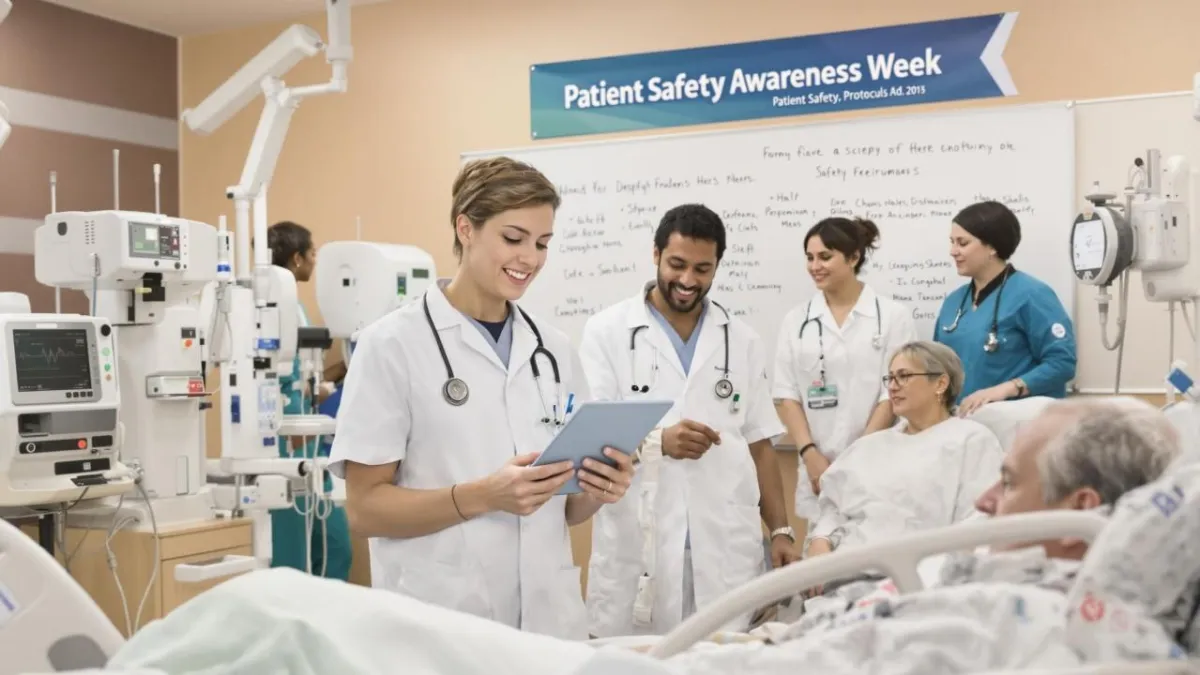Patient Safety Awareness Week: Building a Culture of Safety in Healthcare
Date published: March 13, 2025

Theme for 2025: Moving the Needle
In the ever-evolving landscape of healthcare, ensuring patient safety is a top priority. Patient Safety Awareness Week 2025, observed annually, serves as a vital reminder of the importance of fostering a culture of safety in healthcare settings. This year’s theme, “Moving the Needle,” emphasizes the need for measurable progress in patient safety initiatives, encouraging healthcare organizations to take actionable steps toward improving outcomes and reducing harm.
One of the most effective ways to achieve this is by addressing key factors that impact patient safety, such as communication, teamwork, and safe nursing staffing levels. These elements are not just operational concerns; they are critical components in preventing harm events and improving patient outcomes. For healthcare leaders, promoting patient safety is a proactive responsibility that aligns with the principles of High Reliability Organizations (HROs), which emphasize anticipating and mitigating risks before they result in harm.
Why Patient Safety Awareness Week Matters
Patient Safety Awareness Week is more than just a campaign; it is a movement to highlight the importance of safety in every aspect of healthcare. The complexity of modern healthcare has introduced new challenges, from increased patient acuity to the growing demands on healthcare systems. These challenges underscore the need for a dedicated focus on safety practices that protect patients and support healthcare professionals.
This year’s theme, “Moving the Needle,” reflects the urgency of making tangible progress in patient safety. It calls on healthcare organizations to evaluate their current practices, identify areas for improvement, and implement strategies that lead to measurable outcomes.
By prioritizing patient safety, healthcare organizations can foster a culture of vigilance, accountability, and continuous improvement. This proactive approach aligns with the HRO framework, which emphasizes the importance of identifying risks and implementing strategies to prevent harm before it occurs.
Key Areas of Focus for Patient Safety
Patient Safety Awareness Week 2025 encourages healthcare organizations to address several critical areas that directly impact safety, including:
1. Safe Nursing Staffing
Adequate staffing levels are essential to ensure that nurses have the time, resources, and capacity to provide high-quality care. Safe staffing reduces the likelihood of errors, enhances patient monitoring, and prevents nurse burnout, all of which contribute to better patient outcomes.
2. Effective Communication
Clear and open communication among healthcare teams is vital to minimizing miscommunication and its associated risks. Encouraging transparency and collaboration fosters a safer environment for both patients and staff.
3. Patient Engagement
Involving patients in their care decisions empowers them to be active participants in their healthcare journey. Educating patients about their conditions, treatments, and safety measures can reduce errors and improve satisfaction.
4. Technology and Innovation
Leveraging technology, such as electronic health records (EHRs) and predictive analytics, can help identify potential risks and streamline care processes. However, it is essential to ensure that technology is implemented thoughtfully to avoid introducing new safety challenges.
Challenges in Ensuring Patient Safety
Despite the progress made in patient safety, significant challenges remain. These include:
Workforce Shortages: A nationwide shortage of healthcare professionals, particularly nurses, has made it difficult to maintain optimal staffing levels.
Burnout and Fatigue: Overworked staff are more likely to experience burnout, which can compromise patient safety and lead to high turnover rates.
Financial Pressures: Budget constraints often force organizations to make difficult decisions, sometimes at the expense of safety initiatives.
Resistance to Change: Implementing new safety protocols or reforms can face resistance from stakeholders focused on short-term goals.
The Role of Leadership in Patient Safety
Leadership plays a pivotal role in advancing patient safety. Healthcare leaders must adopt a proactive approach, recognizing that safety is not just a regulatory requirement but a moral imperative. By embracing the principles of HROs, leaders can:
Anticipate Risks: Use data and analytics to identify potential safety concerns and address them before they escalate.
Allocate Resources: Ensure that budgets and resources are aligned with safety goals, even during financial constraints.
Foster a Culture of Safety: Encourage open communication, transparency, and accountability to create an environment where safety is a shared responsibility.
Support Staff: Provide training, mentorship, and wellness programs to empower healthcare professionals and reduce burnout.
Conclusion
Patient Safety Awareness Week 2025, with its theme “Moving the Needle,” is a powerful reminder of the collective responsibility to protect patients and improve healthcare outcomes. By addressing challenges such as safe staffing, effective communication, and workforce well-being, healthcare organizations can create a culture of safety that aligns with the principles of High Reliability Organizations.
Patient safety is not just a goal; it is a commitment to continuous improvement and a moral obligation to protect lives. As we observe Patient Safety Awareness Week 2025, let us reaffirm our dedication to fostering safer healthcare environments for patients, families, and healthcare professionals alike.
For more insights into improving healthcare practices and fostering a culture of safety, visit Dr. Julie Siemers' website. Together, we can create a safer, more effective healthcare system.
#PatientSafety #HealthcareLeadership #SafeStaffing #MovingTheNeedle #PatientCare
Patient Safety Awareness Week: Building a Culture of Safety in Healthcare
Date published: March 13, 2025

Theme for 2025: Moving the Needle
In the ever-evolving landscape of healthcare, ensuring patient safety is a top priority. Patient Safety Awareness Week 2025, observed annually, serves as a vital reminder of the importance of fostering a culture of safety in healthcare settings. This year’s theme, “Moving the Needle,” emphasizes the need for measurable progress in patient safety initiatives, encouraging healthcare organizations to take actionable steps toward improving outcomes and reducing harm.
One of the most effective ways to achieve this is by addressing key factors that impact patient safety, such as communication, teamwork, and safe nursing staffing levels. These elements are not just operational concerns; they are critical components in preventing harm events and improving patient outcomes. For healthcare leaders, promoting patient safety is a proactive responsibility that aligns with the principles of High Reliability Organizations (HROs), which emphasize anticipating and mitigating risks before they result in harm.
Why Patient Safety Awareness Week Matters
Patient Safety Awareness Week is more than just a campaign; it is a movement to highlight the importance of safety in every aspect of healthcare. The complexity of modern healthcare has introduced new challenges, from increased patient acuity to the growing demands on healthcare systems. These challenges underscore the need for a dedicated focus on safety practices that protect patients and support healthcare professionals.
This year’s theme, “Moving the Needle,” reflects the urgency of making tangible progress in patient safety. It calls on healthcare organizations to evaluate their current practices, identify areas for improvement, and implement strategies that lead to measurable outcomes.
By prioritizing patient safety, healthcare organizations can foster a culture of vigilance, accountability, and continuous improvement. This proactive approach aligns with the HRO framework, which emphasizes the importance of identifying risks and implementing strategies to prevent harm before it occurs.
Key Areas of Focus for Patient Safety
Patient Safety Awareness Week 2025 encourages healthcare organizations to address several critical areas that directly impact safety, including:
1. Safe Nursing Staffing
Adequate staffing levels are essential to ensure that nurses have the time, resources, and capacity to provide high-quality care. Safe staffing reduces the likelihood of errors, enhances patient monitoring, and prevents nurse burnout, all of which contribute to better patient outcomes.
2. Effective Communication
Clear and open communication among healthcare teams is vital to minimizing miscommunication and its associated risks. Encouraging transparency and collaboration fosters a safer environment for both patients and staff.
3. Patient Engagement
Involving patients in their care decisions empowers them to be active participants in their healthcare journey. Educating patients about their conditions, treatments, and safety measures can reduce errors and improve satisfaction.
4. Technology and Innovation
Leveraging technology, such as electronic health records (EHRs) and predictive analytics, can help identify potential risks and streamline care processes. However, it is essential to ensure that technology is implemented thoughtfully to avoid introducing new safety challenges.
Monitoring and Reporting
Collecting and analyzing data on safety incidents to identify trends and areas for improvement.
Establishing Standards
Developing and enforcing safety protocols to ensure consistency and quality across healthcare organizations.
Promoting Education
Providing training and resources to healthcare professionals to enhance their knowledge and skills in patient safety.
Encouraging Transparency
Creating a culture where healthcare workers feel empowered to report errors and near-misses without fear of retribution.

Driving Innovation
Leveraging technology and research to implement cutting-edge solutions for patient safety challenges.

Challenges in Ensuring Patient Safety
Despite the progress made in patient safety, significant challenges remain. These include:
Workforce Shortages: A nationwide shortage of healthcare professionals, particularly nurses, has made it difficult to maintain optimal staffing levels.
Burnout and Fatigue: Overworked staff are more likely to experience burnout, which can compromise patient safety and lead to high turnover rates.
Financial Pressures: Budget constraints often force organizations to make difficult decisions, sometimes at the expense of safety initiatives.
Resistance to Change: Implementing new safety protocols or reforms can face resistance from stakeholders focused on short-term goals.
The Role of Leadership in Patient Safety
Leadership plays a pivotal role in advancing patient safety. Healthcare leaders must adopt a proactive approach, recognizing that safety is not just a regulatory requirement but a moral imperative. By embracing the principles of HROs, leaders can:
Anticipate Risks: Use data and analytics to identify potential safety concerns and address them before they escalate.
Allocate Resources: Ensure that budgets and resources are aligned with safety goals, even during financial constraints.
Foster a Culture of Safety: Encourage open communication, transparency, and accountability to create an environment where safety is a shared responsibility.
Support Staff: Provide training, mentorship, and wellness programs to empower healthcare professionals and reduce burnout.
Conclusion
Patient Safety Awareness Week 2025, with its theme “Moving the Needle,” is a powerful reminder of the collective responsibility to protect patients and improve healthcare outcomes. By addressing challenges such as safe staffing, effective communication, and workforce well-being, healthcare organizations can create a culture of safety that aligns with the principles of High Reliability Organizations.
Patient safety is not just a goal; it is a commitment to continuous improvement and a moral obligation to protect lives. As we observe Patient Safety Awareness Week 2025, let us reaffirm our dedication to fostering safer healthcare environments for patients, families, and healthcare professionals alike.
For more insights into improving healthcare practices and fostering a culture of safety, visit Dr. Julie Siemers' website. Together, we can create a safer, more effective healthcare system.
#PatientSafety #HealthcareLeadership #SafeStaffing #MovingTheNeedle #PatientCare
